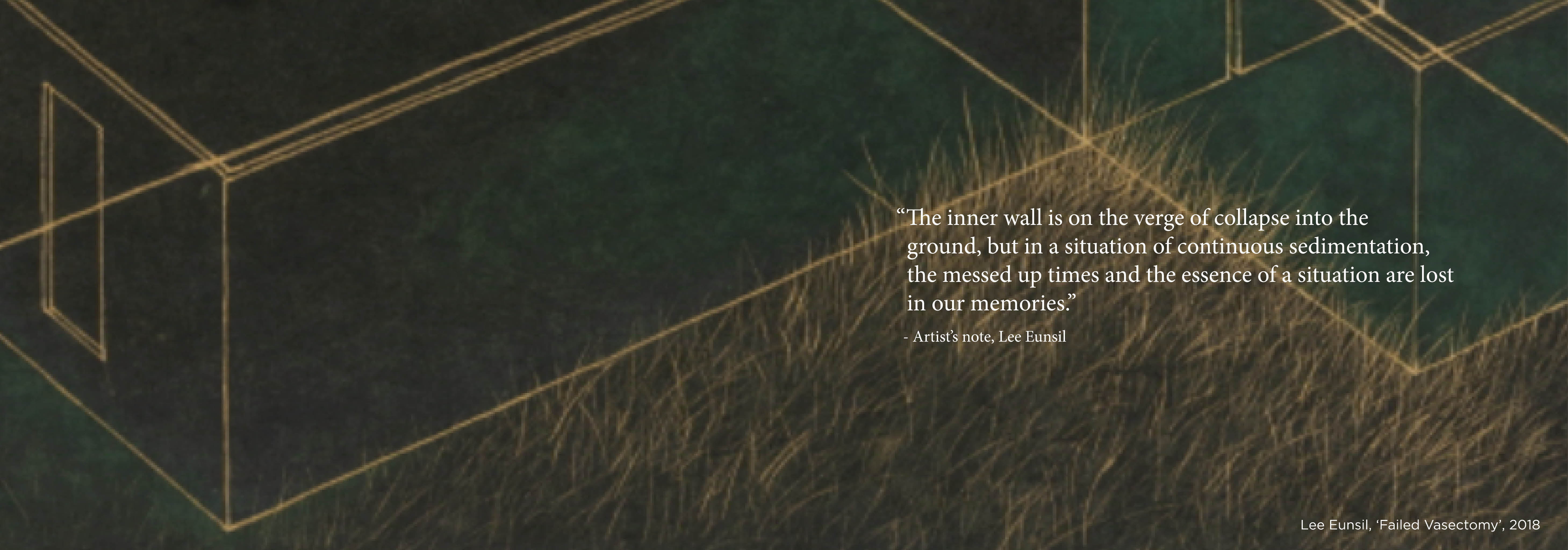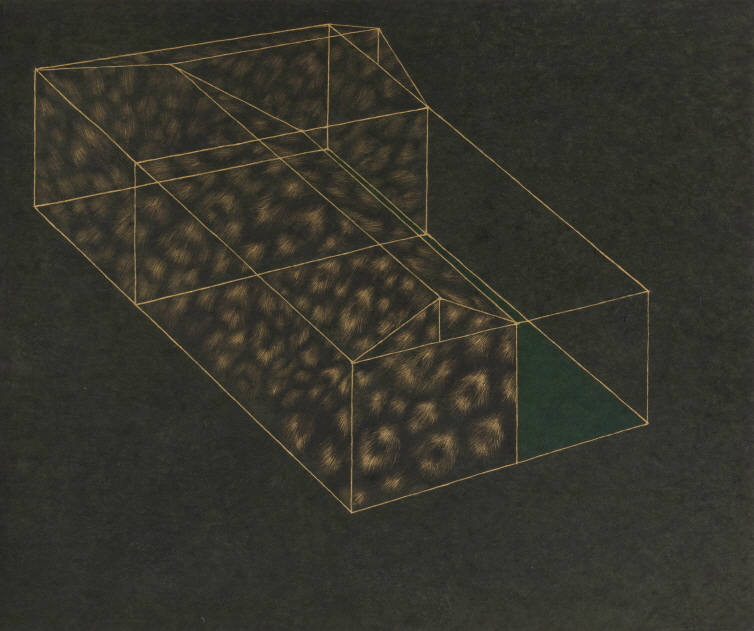In his seminal paper on personality psychology The Ego and the Id (1923), Sigmund Freud described three agencies of the mind that constantly compete for mastery over the mental life of a person. The id, which operates within the human subconscious, comprises the inborn emotional impulses and physical desires that drive one’s carnal instincts. The superego functions as one’s moral conscience by reflecting the values and norms learned from society while projecting an image of the ideal self. Balancing these two oppositional forces is the ego, or conscious mind, which responds to conditions in the real world and strives to control both the id and the superego in an endless struggle for dominance within the human psyche.
Eunsil Lee visualizes the ego as it contends with these psychological forces, centering on the complex, bottled-up emotions that give rise to psychological disorders. In her previous bodies of work, Lee engaged the ego's suppression of the id through a distinct figurative vocabulary: alongside landscape and architectural motifs that harken to the conventions of Korean ink painting, she inserted images of copulating tigers and other animals, infusing her works with an unsettling visual intensity. The fraught psychosexual energies manifested in these pseudo-allegorical paintings reflect the artist’s stymied attempts at reconciling the polemics of traditional gender roles that hold sway over our social interactions as well as the behavioral strictures that regulate our primal urges.
In her recent work, Lee shifts her creative inquiry toward the internal tug-of-war between the ego and superego. In this dynamic, the moralizing superego asserts a critical impetus that punishes the ego for its inability to completely internalize and subjugate the impulses of the id. Since the superego’s prime directive is that of perfection, the ego inevitably falls short of its exacting standards, resulting in feelings of guilt, anxiety and inferiority that reinforce the ethical ideals imposed upon the self by society at large. Such sentiments establish the preconditions for psychological disorders including paranoia and schizophrenia whereby the ego is unable to distinguish between what is real and what is imagined.
“Unstable Dimension” offers multiple viewpoints onto the conflict between ego and superego, configuring a distorted matrix of space and time that evinces a psychopathological detachment from reality. Lee’s paintings collIn his seminal paper on personality psychology The Ego and the Id (1923), Sigmund Freud described three agencies of the mind that constantly compete for mastery over the mental life of a person. The id, which operates within the human subconscious, comprises the inborn emotional impulses and physical desires that drive one’s carnal instincts. The superego functions as one’s moral conscience by reflecting the values and norms learned from society while projecting an image of the ideal self. Balancing these two oppositional forces is the ego, or conscious mind, which responds to conditions in the real world and strives to control both the id and the superego in an endless struggle for dominance within the human psyche.
Eunsil Lee visualizes the ego as it contends with these psychological forces, centering on the complex, bottled-up emotions that give rise to psychological disorders. In her previous bodies of work, Lee engaged the ego's suppression of the id through a distinct figurative vocabulary: alongside landscape and architectural motifs that harken to the conventions of Korean ink painting, she inserted images of copulating tigers and other animals, infusing her works with an unsettling visual intensity. The fraught psychosexual energies manifested in these pseudo-allegorical paintings reflect the artist’s stymied attempts at reconciling the polemics of traditional gender roles that hold sway over our social interactions as well as the behavioral strictures that regulate our primal urges.
In her recent work, Lee shifts her creative inquiry toward the internal tug-of-war between the ego and superego. In this dynamic, the moralizing superego asserts a critical impetus that punishes the ego for its inability to completely internalize and subjugate the impulses of the id. Since the superego’s prime directive is that of perfection, the ego inevitably falls short of its exacting standards, resulting in feelings of guilt, anxiety and inferiority that reinforce the ethical ideals imposed upon the self by society at large. Such sentiments establish the preconditions for psychological disorders including paranoia and schizophrenia whereby the ego is unable to distinguish between what is real and what is imagined.
“Unstable Dimension” offers multiple viewpoints onto the conflict between ego and superego, configuring a distorted matrix of space and time that evinces a psychopathological detachment from reality. Lee’s paintings collectively posit an indeterminate spatiotemporal sensibility characterized by physical dislocations and overlays as well as divergent chronologies. The exhibition’s eponymous work proposes a ruptured dimensionality of pictorial space underscored by arrays of volumetric compartments with varying opacity and planar forms devoid of materiality, each enfolding a distinct moment in time. Three disembodied human brains, still attached to clusters of severed nerves, float over various configurations of these rectilinear time-spaces, delimiting the duration of their fractured existence; on the periphery of these constrained mental masses, a set of hovering female and male sex organs project a liminal presence of ambiguous relationality. Somewhere beneath it all, faintly rendered mountains and waterfalls suggest a diffuse landscape that conflates disparate focal ranges to further destabilize the work’s surreal subjectivity.
Throughout Lee’s new corpus, texture and density are two constant vectors of expression lending substance to her visions of mental distress. By modulating these variables, she invites pluralistic perceptions that transcend ontological distinctions. These are paintings of psychological states that cannot be put into words; they bespeak the turmoil and volatility inherent in the perpetual battle raging within all of us as the constituent agencies of the mind jostle for supremacy over our sense of self.
ectively posit an indeterminate spatiotemporal sensibility characterized by physical dislocations and overlays as well as divergent chronologies. The exhibition’s eponymous work proposes a ruptured dimensionality of pictorial space underscored by arrays of volumetric compartments with varying opacity and planar forms devoid of materiality, each enfolding a distinct moment in time. Three disembodied human brains, still attached to clusters of severed nerves, float over various configurations of these rectilinear time-spaces, delimiting the duration of their fractured existence; on the periphery of these constrained mental masses, a set of hovering female and male sex organs project a liminal presence of ambiguous relationality. Somewhere beneath it all, faintly rendered mountains and waterfalls suggest a diffuse landscape that conflates disparate focal ranges to further destabilize the work’s surreal subjectivity.
Throughout Lee’s new corpus, texture and density are two constant vectors of expression lending substance to her visions of mental distress. By modulating these variables, she invites pluralistic perceptions that transcend ontological distinctions. These are paintings of psychological states that cannot be put into words; they bespeak the turmoil and volatility inherent in the perpetual battle raging within all of us as the constituent agencies of the mind jostle for supremacy over our sense of self.




















